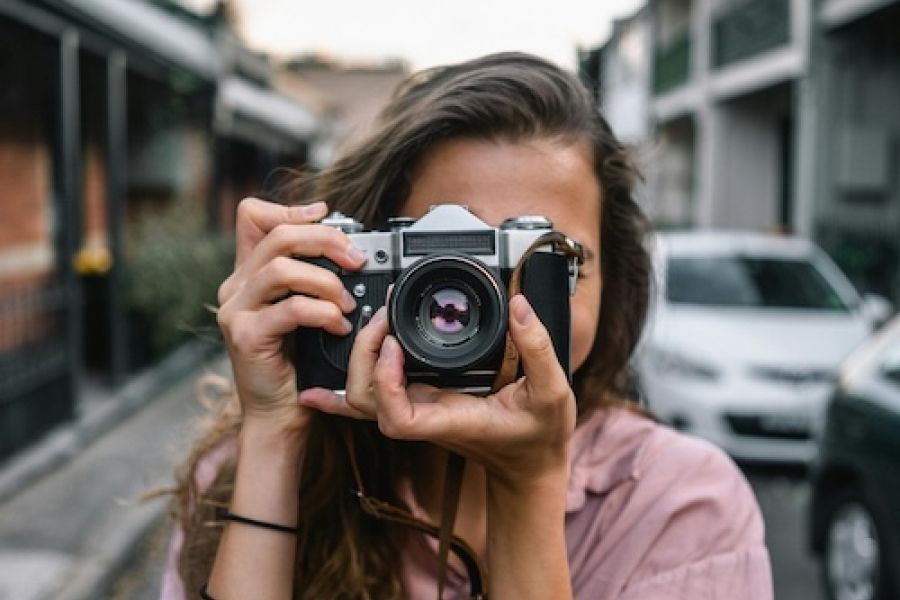Photography
This program is designed to give you the first two years of a bachelor’s degree.
What You'll Learn
Capture compelling visual narratives through technical mastery and artistic expression.
Explore the art and craft of visual storytelling. You’ll develop your technical skills in lighting, composition, and digital editing while refining your creative voice. From commercial photography to fine art, opportunities for skilled photographers continue to expand in media, marketing, and design. You’ll build a strong portfolio that reflects both your artistic vision and your ability to work professionally in creative industries.
Where You’ll Go

Photographers
- Adjust apertures, shutter speeds, and camera focus according to a combination of factors, such as lighting, field depth, subject motion, film type, and film speed.
- Create artificial light, using flashes and reflectors.
- Transfer photographs to computers for editing, archiving, and electronic transmission.
- Determine desired images and picture composition, selecting and adjusting subjects, equipment, and lighting to achieve desired effects.
Salary information presented are estimates and can be different for each individual based on education, experience, and the specific employer. Labor market data is based on 2025 estimates derived from Lightcast (Career Coach | Lightcast)
The careers listed above are just a starting point. Our programs mix together important concepts and hands-on skills—but that doesn’t mean your future has to follow the same script. Find out more at Career Exploration & Support.
Program Requirements
To graduate [ 61-63 credits + 2.0 GPA or higher ]
| Course ID | Course Name | Credits | Minimum Grade |
|---|---|---|---|
| ENGL098 | Accelerated Writing Skills for ENGL 100 | 3 | |
| RDNG116 | College Reading and Study Skills | 3 | |
| MATH017 | Skills & Support Quantitative Reasoning | 1 | |
| or MATH020 | Skills & Support for College Algebra | 2 | |
| or MATH029 | Skills & Support for Statistics | 3 |
| Course ID | Course Name | Credits | Minimum Grade |
|---|---|---|---|
| ART 111 | Photography I | 3 | |
| ART 117 | Design Foundations I | 3 | |
| ART 120 | Drawing I | 3 | |
| ENGL100 | Academic Writing I | 3 | |
| or GENERIC | A student exempt from ENGL100 must substitute a three-credit liberal arts elective. The course should be in consultation with the student’s advisor. | ||
| SUNY GE #3 Mathematics | Mathematics | 3 - 4 | |
| or GENERIC | The course should be selected in consultation with the student's advisor in accord with the student’s transfer plans. |
| Course ID | Course Name | Credits | Minimum Grade |
|---|---|---|---|
| ART 104 | History of Photography and Video | 3 | |
| ART 118 | Design Foundations II | 3 | |
| ART 212 | Digital Photography | 3 | |
| ENGL101 | Academic Writing II | 3 | |
| or ENGL101H | Academic Writing II-Honors | 3 | |
| SUNY GE #4 Natural Sciences | Natural Sciences | 3 - 4 |
| Course ID | Course Name | Credits | Minimum Grade |
|---|---|---|---|
| ART 101 | Art History: Ancient to Early Medieval | 3 | |
| ART 112 | Photography II | 3 | |
| ART 255 | Lighting Principles | 3 | |
| ART 262 | Photography Portfolio | 1 | |
| ENGL102 | Approaches to Literature | 3 | |
| SUNY GE #6 Social Science | Social Science | 3 |
| Course ID | Course Name | Credits | Minimum Grade |
|---|---|---|---|
| ART 102 | Art History: Renaissance to Contemporary | 3 | |
| ART 213 | Dynamic Media I | 3 | |
| ART 222 | Advanced Digital Photography | 3 | |
| ENGL201 | Public Speaking | 3 | |
| or ENGL201H | Public Speaking - Honors | 3 | |
| or ENGL204 | Interpersonal Communication | 3 | |
| or ENGL210 | Intercultural Communication | 3 | |
| ALEX210 | Ke’lab: The Arts Publication | 3 | |
| or ALEX233 | Project-Based Learning | 3 | |
| or ALEX249 | Special Topics: Project-Based Learning | 2 | |
| or ART 106 | Introduction to Photojournalism | 3 | |
| or ART 233 | Animation | 3 | |
| or ART 248 | Word & Photographic Image | 3 | |
| or ART 290 | Independent Art Studio-Photography | 3 | |
| or COMM115 | Introduction to Digital Video | 3 | |
| or GENERIC | Restricted Elective: Select at 3 credit ALEX course approve by the department chair or chose from the following courses: ART106, ART 233, ART 248, ART 290, COMM115. | 3 |
| Transfer School Sort descending | Transfer Program |
|---|---|
Transfer School: Hobart and William Smith Colleges |
Transfer Programl: Multiple Programs |
Transfer School: Syracuse University |
Transfer Programl: College of Professional Studies |

